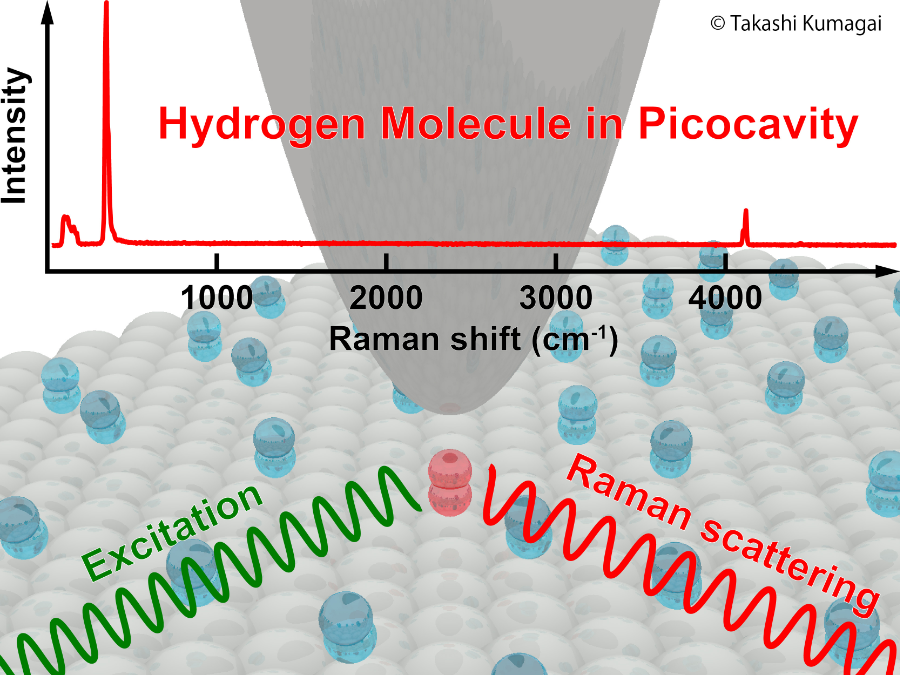Summary
- Achieved the first spectroscopic observation of hydrogen (H2) and deuterium (D2) molecules physically adsorbed within an atomic-scale space known as a picocavity.
- Employed picometric rotational/vibrational spectroscopy to elucidate their structure and dynamics at the single-molecule level.
- Observed distinct spectral responses for H2 and D2, and theoretically demonstrated that these differences arise from non-trivial isotope effects due to quantum nuclear effects.
- This advancement in precision molecular spectroscopy within picocavities opens new possibilities for well-controlled studies of functional materials for energy applications, such as hydrogen storage systems and catalytic surfaces, as well as for developing single-molecule quantum control technologies.
Overview
An international research team, led by Akitoshi Shiotari of the Fritz Haber Institute of the Max Planck Society (Germany), Mariana Rossi of the Max Planck Institute for the Structure and Dynamics of Matter (Germany), and Takashi Kumagai of the Institute for Molecular Science/SOKENDAI (Japan) has successfully achieved single-molecule spectroscopic observation of hydrogen (H2) and deuterium (D2) confined within a picocavity. The picocavity was formed between a silver nanotip and a silver single-crystal substrate under cryogenic and ultrahigh vacuum conditions, using tip-enhanced Raman spectroscopy (TERS).
In recent years, light-matter interactions within atomic-scale volumes, known as picocavities, have attracted growing attention in nanoscience and nanotechnology. The extremely confined electromagnetic field generated by plasmon resonance is now regarded as a promising platform for atomic-scale measurements and quantum photonic technologies.
In this study, the smallest molecule--hydrogen--was confined within a picocavity and investigated using high-resolution TERS. This enabled picometric molecular spectroscopy to resolve its vibrational and rotational modes with unprecedented detail, revealing how the structure and vibrational properties of a single molecule are affected by the extreme spatial confinement of the picocavity. Furthermore, by precisely adjusting the gap distance between the silver tip and the silver substrate, the subtle interaction with the molecule is modified. As a result, it was discovered that only the vibrational mode of H2, and not D2, exhibited a significant change, demonstrating a pronounced isotope-dependent effect--that could not be captured by ensemble-averaged Raman or other conventional vibrational spectroscopies.
To elucidate the origin of this nontrivial isotope effect, the team conducted theoretical simulations using density functional theory (DFT), path-integral molecular dynamics (PIMD), and model Hamiltonians. These calculations revealed that the spectroscopy is exquisitely sensitive to the local interaction potential experienced by the molecules, dominated by van der Waals interactions. Quantum delocalization of the nuclei--a quantum swelling effect at low temperatures -- plays a decisive role in the observed differences, favoring distinct equilibrium positions for H2 and D2 in the picocavity, which lead to a substantial difference in their vibrational spectra. Dr. Rossi says, "We were surprised at how vibrational coupling and nuclear quantum effects work hand-in-hand to cause such a large isotope effect".
Dr. Shiotari says, "This work deepens our understanding of light-molecule interactions and the quantum dynamics of adsorbed molecules in extremely confined spaces, representing a significant step forward in precision molecular spectroscopy." Prof. Kumagai adds, "Looking ahead, the methods and insights developed here are expected to contribute to the advanced analysis of hydrogen storage materials and catalytic reactions, as well as to the development of quantum control technologies for individual molecules--thereby supporting next-generation nanoscale sensing and quantum photonic technologies."

Raman scattering of a hydrogen molecule in a plasmonic picocavity
(Credit: Takashi Kumagai, Restriction: CC BY)
Researcher Information:
National Institutes of Natural Sciences, Institute for Molecular Science
Takashi Kumagai (Associate Professor)
Toshiki Sugimoto (Associate Professor)
Fritz Haber Institute of the Max Planck Society
Akitoshi Shiotari (Group Leader)
Shuyi Liu (Postdoc, currently professor at Huazhong University of Science and Technology)
Martin Wolf (Director)
Max Planck Institute for the Structure and Dynamics of Matter
Mariana Rossi (Independent Group Leader)
George Trenins (Postdoc)
Information of the paper
Authors: Akitoshi Shiotari*, Shuyi Liu, George Trenins, Toshiki Sugimoto, Martin Wolf, Mariana Rossi*, Takashi Kumagai* (* Corresponding Authors)
Journal Name: Physical Review Letters
Journal Title: "Picocavity-Enhanced Raman Spectroscopy of Physisorbed H2 and D2 Molecules"
DOI: 10.1103/PhysRevLett.134.206901
Research Funding:
JST FOREST (JPMJFR201J, JPMJFR221U)
Contact Information:
(For inquiries about the research, please contact the presenters)
Fritz Haber Institute of the Max Planck Society
Akitoshi Shiotari
Tel: +49-30-8413-5181
E-mail: shiotari_at_fhi-berlin.mpg.de (Please replace the "_at_" with @)
Max Planck Institute for the Structure and Dynamics of Matter
Mariana Rossi
Tel: +49 40 8998 88360
E-mail: mariana.rossi_at_mpsd.mpg.de (Please replace the "_at_" with @)
National Institutes of Natural Sciences, Institute for Molecular Science/SOKENDAI
Takashi Kumagai
Tel: +81 564-55-7410
E-mail: kuma_at_ims.ac.jp (Please replace the "_at_" with @)
4693
3970,4673

